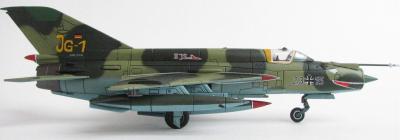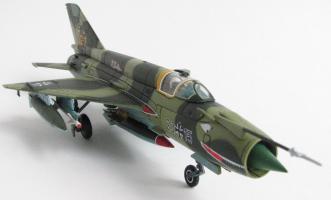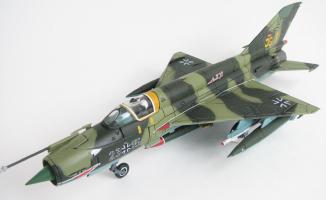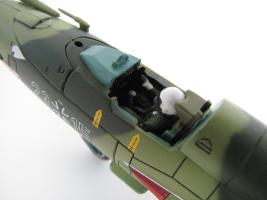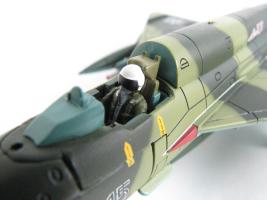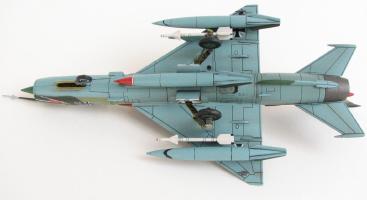Hobby Master Archive
Air Power Jets 1/72
MiG-21
Mig-21MF JG-1 model plane
HOBBY MASTER MIG-21MF: 1/72 scale. Die-cast metal with a minimum use of plastic. Canopy can be displayed open or closed. Model comes with a display stand. Landing gear can be displayed closed or in the down position. Rubber tires. A large assortment of weapons. Fully assembled and painted. Comes with pilot figure. Markings are tampo applied not decals.
Historic Background of JG-1: The East German Air Force, of which JG-1 squadrons 2/1 based at Holzdorf were part of, flew the MF, SPS and UM versions of the Mig-21. As part of the National Peoples Army of the German Democratic Republic, it disappeared from the existence on October 3, 1990. This is the official date of the German reunification. The East German “National Volksarmee” used to be amongst the better armed forces of the Warsaw Pact. Its personnel was very well trained, motivated and compensated. The equipment was rather old and mostly outdated, but relatively well maintained. The West Germans considered the age of the planes and basically dismantled, destroyed, or sold most of the East German material. Only a few aircraft were taken over by the Luftwaffe; mainly transport airplanes and helicopters of the Mi-2 and Mi-8 type. The MiG-29 was the only fighter to be taken over by the West Germans since it was a fighter jet that was capable of outperforming everything they had. It now is the most maneuverable fighter in the Luftwaffe’s arsenal and will be until the arrival of the Eurofighter 2000.
Mig-21 History: The Mig-21 was originally built by the Mikoyan and Gurevich Design Bureau in the Soviet Union with a NATO nickname “Fishbed”. No other jet has had as many planes produced as the Mig-21. Depending on the reference source 8,000 - 13,000 planes of all versions were made in the Soviet Union, under license to allied countries and China without license. At the time of it’s introduction into the Soviet Air Force service in 1959, it was exactly what they wanted. A small, fast, agile, dependable and most importantly simple making it easy to turn out great numbers of the plane. The skies of Eastern Europe, Africa, Asia and Central America seemed to be filled with thousands of the Mig-21. Because of it’s relatively low cost since it was heavily subsidized by the Soviets, it became the plane of choice for many third world countries. Taking this into account this plane this plane has seen more wars then any other modern day jet. The Mig-21 was used in front line service for over 30 years equaling that of the McDonnell Douglas F-4 Phantom II. There were 5 generations of the plane in many versions and each generation brought with it great improvements over it’s predecessors. These are some of the countries that flew the Mig-21: Afghanistan, Albania, Algeria, Angola, Azerbaijan, Bangladesh, Burkina Faso, Bulgaria, Cambodia, China, Congo, Croatia, Cuba, Czech Republic, Egypt, Ethiopia, Finland, GDR, Guinea, Hungary, India, Indonesia, Iran, Iraq, Laos, Libya, Madagascar, Mali, Mongolia, Mozambique, Myanmar (formerly Burma), Nigeria, North Korea, Pakistan, Poland, Romania, Serbia, Slovakia, Somalia, Soviet Union, Sri Lanka, Sudan, Syria, Tanzania, Turkmenistan, Uganda, Ukraine, Vietnam, Yemen, Zambia, Zimbabwe.
Mig-21MF Specs:
Power Plant: One 41.55kN (9,340lb st) or 64.73kN (14,550lb st) with afterburner Tumansky R-13-300 turbojet Wingspan: 7.15m (23ft 5½in) Length: 15.76m (51ft 8½in) - incl pitot boom Max T-O weight: 9,400kg (20,725lb) Max speed: Mach 2.1 (2,230km/h - 1,385mph) above 11,000m (36,000ft) Mach 1.06 (1,300km/h - 807mph) at low level Range: 1,100km (683 miles) - internal fuel only 1,800km (1,118 miles) - with three external drop tanks, one under fuselage, one under each wing Armament: One 23mm twin-barrel GSh-23 cannon with 200 rounds in belly pack Various air-to-air and air-to-ground stores carried on four under wing pylons including: K-13A “Atoll” or “Advanced Atoll” a-a missiles, UV-16-57 rocket packs, S-24 a-s rockets, 250kg and 500kg bombs
Versions made including test models: Ye-2 Faceplate : Swept-wing prototype. Ye-4 (I-500) : The first delta wing prototype of the MiG-21. Ye-5 Fishbed : Delta wing research prototype. Ye-6 : Three pre-production aircraft. MiG-21 : The first series of fighters. MiG-21F Fishbed -B : Single-seat day fighter aircraft. It was the first production aircraft, with 40 machines being made. The MiG-21F was powered by a Tumansky R-11 turbojet engine and armed with two 30-mm NR-30 cannon. Prototype Ye-6T was redesignated MiG-21F. Ye-50 : Swept wing research prototype. Ye-66 : Single-seat version, built for breaking the world speed record. Ye-66A : Built to break the world altitude record. Ye-66B : Ye-76 : Ye-152 : Bigger than a MiG-21, the Ye-152 Flipper was a high-performance aircraft, which achieved at least 3 world records. MiG-21F-13 Fishbed-C : Single-seat short-range day fighter. The MiG-21F-13 was the first mass production model. The MiG-21F-13 was powered by a Tumansky R-11 turbojet engine, it was armed with two Vympel K-13 (AA-2 Atoll) air-to-air missiles, and one 30-mm NR-30 cannon. The Type 74 is the Indian Air Force designation. The MiG-21F-13 was made in China, and designated Chengdu J-7 or F-7 for export. Chengdu J-7I : The first Chinese production model. Like the MiG-21F-13 it was a single-seat short-range day-fighter, powered by a Wopen WP-7 turbojet engine. It was exported to Albania and Tanzania as the F-7A. MiG-21FL : Export model of the MiG-21PF. Built under licence in India as the Type 77. MiG-21I “Analog” : Testbed for the Tu-144 wing design MiG-21SPS : (East German version) MiG-21P Fishbed-D Single-seat limited all-weather interceptor fighter. Armed with air-to-air missiles only. Also called Fishbed-E by Nato. MiG-21PF Fishbed-D : Single-seat limited all-weather fighter, equipped with a RP21 Sapfir radar. The MiG-21PF is the second production model. Prototype Ye-7, Type 76 Indian Air Force designation. Also called Fishbed-E by NATO. MiG-21PF (SPS) Fishbed-E: MiG-21PFM Fishbed-F : Single-seat limited all-weather fighter, with upgraded radar and a more powerful engine. Improved version of the MiG-21PFS. MiG-21PFS Fishbed-F : Single-seat limited all-weather fighter, with upgraded radar and a more powerful engine. MiG-21 Fishbed-G : Experimental short take-off and landing aircraft. MiG-21R Fishbed-H : Single-seat tactical reconnaissance version of the MiG-21PFM. MiG-21RF Fishbed-J : Single-seat tactical reconnaissance version of the MiG-21MF. MiG-21S Fishbed-J : Single-seat interceptor fighter version, equipped with a RP-22 radar and an external gun pod. (Incorrectly identified by NATO as MiG-21PFMA); E-8, Type 88 Indian Air Force designation. MiG-21SM : Single-seat interceptor fighter version, powered by a Tumansky R-13-300 turbojet engine. MiG-21PFV : High altitude version (perekhvatchik forsirovannij visotnij, high altitude boosted interceptor). MiG-21M : Export version powered by a Tumansky R-13 turbojet engine. Built under license in India as the Type 96. MiG-21MF : Export version powered by a Tumansky R-13 turbojet engine. MiG-21MF Fishbed-J : Single-seat multi-role fighter version, equipped with a RP-22 radar, powered by a Tumansky R-13-300 turbojet engine. MiG-21SMT Fishbed-K : Single-seat multi-role fighter version, powered by a Tumansky R-13 turbojet engine. Increased fuel and ECM capability. (E-9, block 94 and 96) MiG-21bis Fishbed-L : Single-seat multi-role fighter, ground-attack aircraft. The final production model. This version is powered by a Tumansky R-25-300 turbojet engine. MiG-21bis Fishbed-N : Single-seat multi-role fighter, and ground-attack aircraft. MiG-21U Mongol-A : Two-seat training version of the MiG-21F-13. Type 66 Indian Air Force designation. NATO code name “Mongol” MiG-21US Mongol-B : Two-seat training version. Type 68 Indian Air Force designation. MiG-21UT : Two-seat trainer. MiG-21UM Mongol-B : Two-seat training version of the MiG-21MF. Type 69 Indian Air Force designation. JJ-7 : Two-seat training version of the J-7. FT-7 export designation of the JJ-7. MiG-21-93 - Upgraded version. (also the Bison) MiG-21 Lancer Upgraded version for the Romanian Air Force. J-7II : Upgraded version of the J-7. Single-seat limited all-weather fighter, armed with two 30-mm cannon, and powered by the more powerful Wopen WP-7B turbojet engine. It was exported to Egypt, Sudan and Iraq as the F-7B. J-7E : Improved version with more powerful engine. J-7MG : Improved version. J-7III : Single-seat all-weather fighter, powered by a Wopen WP-13 turbojet engine. F-7BS : Export model for Sri Lanka. F-7M Airguard : Export model sold to Bangladesh, Iran, Myanmar (Burma), and Zimbabwe. F-7MP : Export model for Pakistan. F-7P Skybolt : Export model for Pakistan.
Hobby Master 1/72 Air Power Series HA0104 German MIG-21 MF, JG-1 Dec. 1990
| Added to archive | 2015-11-19 |
| Last modified | 2015-11-19 |
